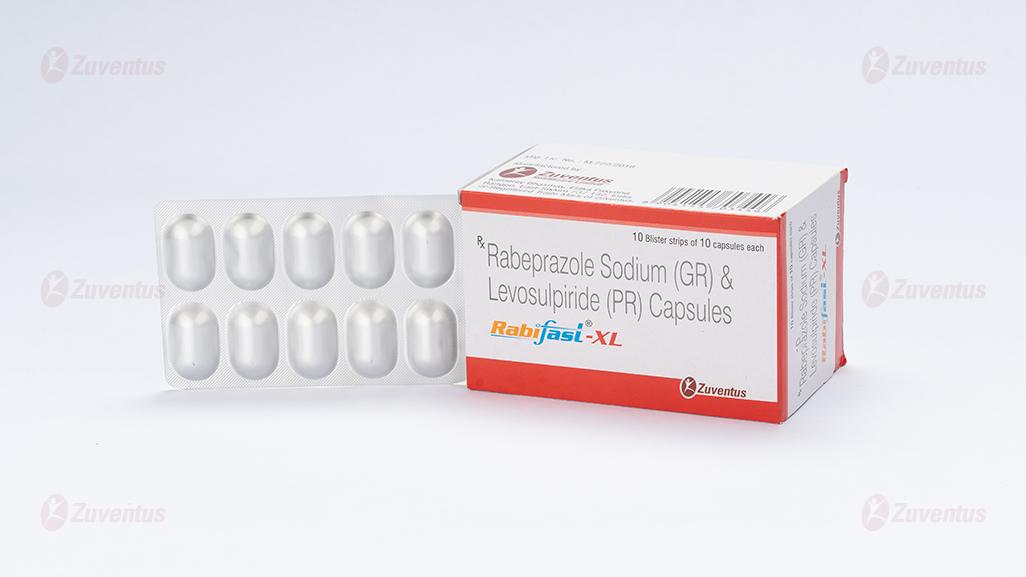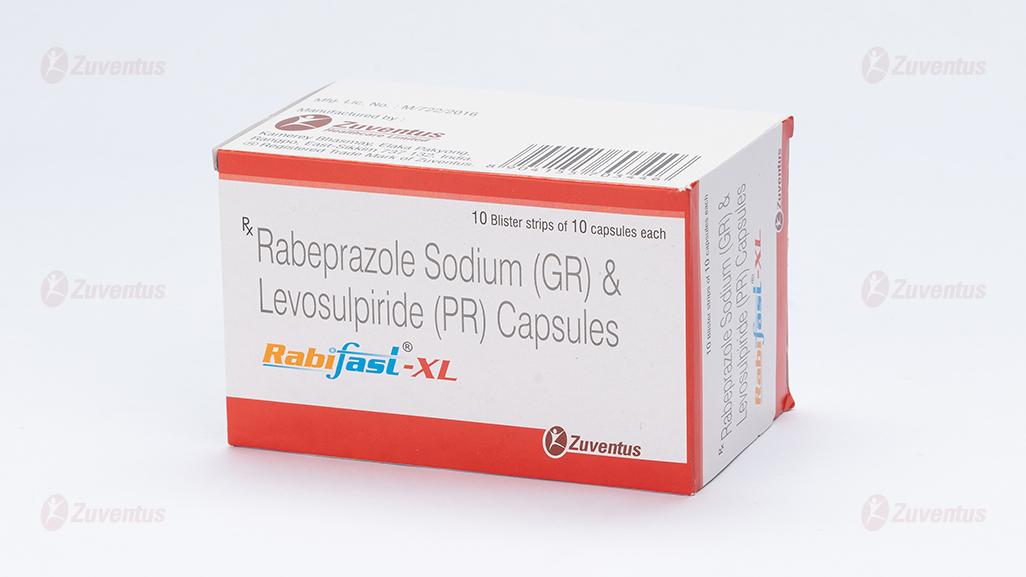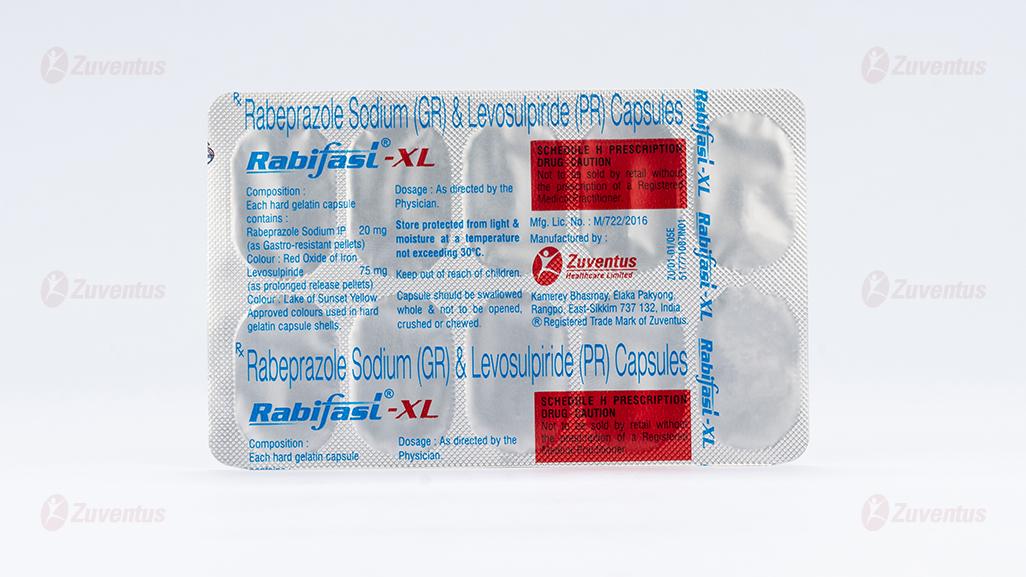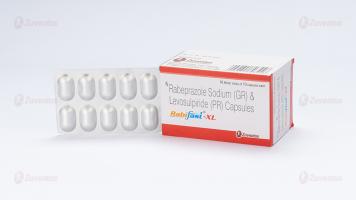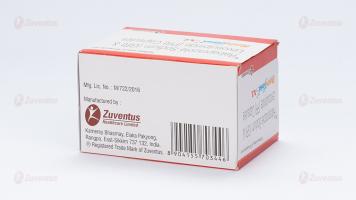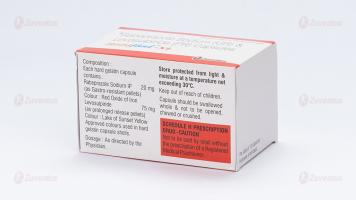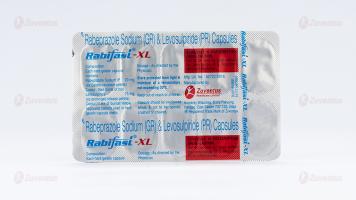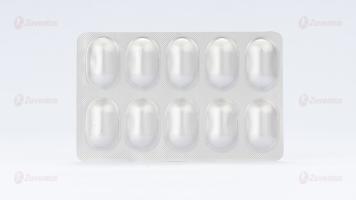Rabifast XL
1.0 Name of the medicinal product
Rabeprazole Sodium (GR) & Levosulpiride (PR) Capsules
2.0 Qualitative and quantitative composition
Rabifast XL
Each hard gelatin capsule contains:
Rabeprazole Sodium IP……………………. 20 mg
(as Gastro-resistant pellets)
Colour: Red Oxide of Iron
Levosulpiride………………………………. 75 mg
(as prolonged release pellets)
Colour: Lake of Sunset Yellow
Approved colours used in hard gelatin capsule shells.
3.0 Dosage form and strength
Capsule
Rabeprazole 20 mg and Levosulpiride 75 mg
4.0 Clinical particulars
4.1 Therapeutic Indication
For the treatment of Gastroesophageal Reflux Disease (GERD)
4.2 Posology and method of administration
Adults
One capsule per day on an empty stomach or as directed by Physician
Paediatric Use
Rabeprazole are not recommended for use in children due to a lack of data on safety and efficacy.
Method of administration
Capsule should be swallowed whole & not to be opened, chewed or crushed.
4.3 Contraindications
- Hypersensitivity to the active substances or to any of the excipients
- Pregnancy and Breast feeding
- Elderly people
- Children less than 14 years of age
- Parkinson disease
- Severe renal or hepatic insufficiency
- History of epilepsy
- Porphyrias
- Breast cancer
- Alcohol intoxication
- Certain tumors like phaeochromocytoma and pituitary prolactinoma
- Hypokalemia
4.4 Special warnings and precautions for use
Rabeprazole
- Symptomatic response to therapy with rabeprazole sodium does not preclude the presence of gastric or oesophageal malignancy, therefore the possibility of malignancy should be excluded. Patients on long-term treatment (particularly those treated for more than a year) should be kept under regular surveillance.
- Patients on long-term treatment (particularly those treated for more than a year) should be kept under regular surveillance.
- A risk of cross-hypersensitivity reactions with other proton pump inhibitor (PPI) or substituted benzimidazoles cannot be excluded.
- Rabeprazole is not recommended for use in children due to a lack of data on safety and efficacy.
- There have been post marketing reports of blood dyscrasias (thrombocytopenia and neutropenia). In the majority of cases where an alternative aetiology cannot be identified, the events were uncomplicated and resolved on discontinuation of rabeprazole.
- Hepatic enzyme abnormalities have been seen in clinical trials and have also been reported since market authorisation. In the majority of cases where an alternative aetiology cannot be identified, the events were uncomplicated and resolved on discontinuation of rabeprazole.
- No evidence of significant drug related safety problems was seen in a study of patients with mild to moderate hepatic impairment versus normal age and sex matched controls. However because there are no clinical data on the use of rabeprazole in the treatment of patients with severe hepatic dysfunction the prescriber is advised to exercise caution when treatment with Rabeprazole is first initiated in such patients.
Co-administration of atazanavir with rabeprazole is not recommended
Treatment with PPIs, including rabeprazole, may possibly increase the risk of gastrointestinal infections such as Salmonella, Campylobacter and Clostridium difficile
Hypomagnesaemia
Severe hypomagnesaemia has been reported in patients treated with PPIs like rabeprazole for at least three months, and in most cases for a year. Serious manifestations of hypomagnesaemia such as fatigue, tetany, delirium, convulsions, dizziness and ventricular arrhythmia can occur but they may begin insidiously and be overlooked. In most affected patients, hypomagnesaemia improved after magnesium replacement and discontinuation of the PPI.
For patients expected to be on prolonged treatment or who take PPIs with digoxin or drugs that may cause hypomagnesaemia (e.g., diuretics), health care professionals should consider measuring magnesium levels before starting PPI treatment and periodically during treatment.
PPIs, especially if used in high doses and over long durations (>1 year), may modestly increase the risk of hip, wrist and spine fracture, predominantly in the elderly or in presence of other recognised risk factors. Observational studies suggest that PPIs may increase the overall risk of fracture by 10–40%. Some of this increase may be due to other risk factors. Patients at risk of osteoporosis should receive care according to current clinical guidelines and they should have an adequate intake of vitamin D and calcium.
Concomitant use of rabeprazole with methotrexate
Literature suggests that concomitant use of PPIs with methotrexate (primarily at high dose; see methotrexate prescribing information) may elevate and prolong serum levels of methotrexate and/or its metabolite, possibly leading to methotrexate toxicities. In high-dose methotrexate administration, a temporary withdrawal of the PPI may be considered in some patients.
Influence on vitamin B12 absorption
Rabeprazole sodium, as all acid-blocking medicines, may reduce the absorption of vitamin B12 (cyanocobalamin) due to hypo- or a- chlorhydria. This should be considered in patients with reduced body stores or risk factors for reduced vitamin B12 absorption on long-term therapy or if respective clinical symptoms are observed.
Subacute cutaneous lupus erythematosus (SCLE)
PPIs are associated with very infrequent cases of SCLE. If lesions occur, especially in sun-exposed areas of the skin, and if accompanied by arthralgia, the patient should seek medical help promptly and the health care professional should consider stopping Rabeprazole. SCLE after previous treatment with a PPI may increase the risk of SCLE with other PPIs.
Interference with laboratory tests
Increased Chromogranin A (CgA) level may interfere with investigations for neuroendocrine tumours. To avoid this interference, Rabeprazole treatment should be stopped for at least 5 days before CgA measurements. If CgA and gastrin levels have not returned to reference range after initial measurement, measurements should be repeated 14 days after cessation of PPI treatment.
Levosulpiride
Caution should be exercised in patients with history of neuroendocrine tumor, epilepsy, manic states, abnormally-high levels of prolactin in the blood, painful, lumpy breasts, heart disease, any allergy, during pregnancy and breastfeeding.
4.5 Drugs interactions
Rabeprazole
Rabeprazole sodium produces a profound and long lasting inhibition of gastric acid secretion. An interaction with compounds whose absorption is pH dependent may occur. Co-administration of rabeprazole sodium with ketoconazole or itraconazole may result in a significant decrease in antifungal plasma levels. Therefore, individual patients may need to be monitored to determine if a dosage adjustment is necessary when ketoconazole or itraconazole are taken concomitantly with rabeprazole.
In clinical trials, antacids were used concomitantly with the administration of rabeprazole and, in a specific drug-drug interaction study, no interaction with liquid antacids was observed.
Co-administration of atazanavir 300 mg/ritonavir 100 mg with omeprazole (40 mg once daily) or atazanavir 400 mg with lansoprazole (60 mg once daily) to healthy volunteers resulted in a substantial reduction in atazanavir exposure. The absorption of atazanavir is pH dependent. Although not studied, similar results are expected with other proton pump inhibitors. Therefore, PPIs, including rabeprazole, should not be co-administered with atazanavir
Methotrexate
Case reports, published population pharmacokinetic studies, and retrospective analyses suggest that concomitant administration of PPIs and methotrexate (primarily at high dose) may elevate and prolong serum levels of methotrexate and/or its metabolite hydroxymethotrexate. However, no formal drug interaction studies of methotrexate with PPIs have been conducted.
Levosulpiride
- Antacids and Sucralfate: They can decrease the absorption of the drug from the intestine. So, these medicines should not be taken along with levosulpiride. There should be a minimum 2 hour time lag between the two medicines.
- Alcohol: there is increased chance of sedation.
- Smoking: increased metabolism of the drug may require higher dose.
- Antihypertensive medications: concomitant use may enhance the hypotensive effect seen with the drug.
- Anticholinergics: increased incidence of anticholinergic side effects.
- Levo dopa: It may oppose the antipsychotic action of the drug, conversely levosulpiride can cause decrease the efficacy of levo-dopa in the management of Parkinsonism.
- Arrhythmia especially prolonged QT interval with the concurrent use of
- Atomoxetine
- Antiarrhythmics
- Terfenadine
- Chloroquine, quinine
- Cisapride
- Drugs causing hypokalemia (corticosteroids, laxatives, diuretics like furosemide)
Use in special populations
Pregnancy
Rabifast XL is not recommended in human pregnancy.
Breast-feeding
It is not known whether rabeprazole sodium is excreted in human breast milk. No studies in lactating women have been performed. Rabeprazole sodium is however excreted in rat mammary secretions. Therefore, Rabifast XL must not be used during breast feeding.
4.6 Effects on ability to drive and use machines
Based on the pharmacodynamic properties and the adverse events profile, it is unlikely that Rabeprazole would cause an impairment of driving performance or compromise the ability to use machinery. Do not drive a car or operate machinery while Levosulpiride may cause dizziness or drowsiness.
4.8 Undesirable effects
Rabeprazole
The most commonly reported adverse drug reactions, during controlled clinical trials with rabeprazole were headache, diarrhoea, abdominal pain, asthenia, flatulence, rash and dry mouth. The majority of adverse events experienced during clinical studies were mild or moderate in severity, and transient in nature.
The following adverse events have been reported from clinical trial and post-marketed experience.
Frequencies are defined as: common (≥1/100 to <1/10), uncommon (≥1/1,000 to <1/100), rare (≥1/10,000 to <1/1,000), very rare (<1/10,000), not known (cannot be estimated from the available data)



1. Includes facial swelling, hypotension and dyspnoea
2. Erythema, bullous reactions and hypersensitivity reactions have usually resolved after discontinuation of therapy.
3. Rare reports of hepatic encephalopathy have been received in patients with underlying cirrhosis. In treatment of patients with severe hepatic dysfunction the prescriber is advised to exercise caution when treatment with Rabeprazole is first initiated in such patients
4. See Special warnings and precautions for use
Levosulpiride
The following side effects can occur with the use of this drug;
- Acute muscular dystonia characterized by abnormal movements (twitching, tremor etc.) of hands, leg, tongue and facial muscles.
- Sedation or drowsiness (because of decrease in sensory inputs to reticular activating system)
- Increase in plasma prolactin levels manifested by breast enlargement, production of milk and stopping of menstrual periods. This can be taken care of with the use of lower dose of this drug.
- Neuroleptic malignant syndrome (characterized by hyperpyrexia, muscle rigidity, increased myoglobin and creatine kinase; the last two suggestive of muscle damage.
- Akathisia (uncontrollable desire to move about without any anxiety).
- Tardive dyskinesia, it occurs late in the therapy and its features include involuntary rhythmical movements of face, mouth and jaw. The reason for tardive dyskinesia is synthesis of newer DA receptors which are supersensitive to even a small amount of DA. This causes a decrease in cholinergic activity in the striatum followed by decrease in GABA release. This decreased in inhibitory GABA is responsible for increased involuntary motor activity.
- Postural hypotension (because of autonomic blockade), tolerance develops to this effect after some time.
- Weight gain.
- Elevated liver transaminases.
Reporting of suspected adverse reactions
Reporting suspected adverse reactions after authorisation of the medicinal product is important. It allows continued monitoring of the benefit/risk balance of the medicinal product. Healthcare professionals are asked to report any suspected adverse reactions via email to: medico@zuventus.com
Website: www.zuventus.co.in and click the tab “Safety Reporting” located on the top end of the home page.
Website link: https://www.zuventus.co.in/drug-safety-reporting
By reporting side effects, you can help provide more information on the safety of this medicine.
4.9 Overdose
Rabeprazole
Experience to date with deliberate or accidental overdose is limited. The maximum established exposure has not exceeded 60 mg twice daily, or 160 mg once daily. Effects are generally minimal, representative of the known adverse event profile and reversible without further medical intervention. No specific antidote is known. Rabeprazole sodium is extensively protein bound and is, therefore, not dialysable. As in any case of overdose, treatment should be symptomatic and general supportive measures should be utilised.
5.0 Pharmacological properties
5.1 Mechanism of Action
Rabeprazole sodium belongs to the class of anti-secretory compounds, the substituted benzimidazoles, that do not exhibit anticholinergic or H2 histamine antagonist properties, but suppress gastric acid secretion by the specific inhibition of the H+/K+-ATPase enzyme (the acid or proton pump). The effect is dose-related and leads to inhibition of both basal and stimulated acid secretion irrespective of the stimulus.
Levosulpride is an atypical antipsychotic agent that blocks the presynaptic dopaminergic D2 receptors.
5.2 Pharmacodynamic properties
Rabeprazole
As a weak base, rabeprazole is rapidly absorbed following all doses and is concentrated in the acid environment of the parietal cells. Rabeprazole is converted to the active sulphenamide form through protonation and it subsequently reacts with the available cysteines on the proton pump. Systemic effects of rabeprazole sodium in the CNS, cardiovascular and respiratory systems have not been found to date. Rabeprazole sodium, given in oral doses of 20 mg for 2 weeks, had no effect on thyroid function, carbohydrate metabolism, or circulating levels of parathyroid hormone, cortisol, oestrogen, testosterone, prolactin, cholecystokinin, secretin, glucagon, follicle stimulating hormone (FSH), luteinising hormone (LH), renin, aldosterone or somatotrophic hormone.
Levosulpiride
Like its parent compound, levosulpiride shows antagonism at D3 and D2 receptors present pre-synaptically as well as post-synaptically in the rat striatum or nucleus accumbens. The preferential binding of the presynaptic dopamine receptors decreases the synthesis and release of dopamine at low doses whereas it causes postsynaptic D2 receptor antagonism at higher dose. This receptor profile of the drug along with its limbic selectivity explains its effectiveness in the management of both positive and negative symptoms of schizophrenia.
5.3 Pharmacokinetic properties
Rabeprazole
Absorption: Rabeprazole, an enteric-coated (gastro-resistant) formulation of rabeprazole sodium. This presentation is necessary because rabeprazole is acid-labile. Absorption of rabeprazole therefore begins only after the capsule leaves the stomach. Absorption is rapid, with peak plasma levels of rabeprazole occurring approximately 3.5 hours after a 20 mg dose. Peak plasma concentrations (Cmax) of rabeprazole and AUC are linear over the dose range of 10 mg to 40 mg. Absolute bioavailability of an oral 20 mg dose (compared to intravenous administration) is about 52 % due in large part to pre-systemic metabolism. Additionally the bioavailability does not appear to increase with repeat administration. In healthy subjects the plasma half-life is approximately one hour (range 0.7 to 1.5 hours), and the total body clearance is estimated to be 283 ± 98 ml/min. There was no clinically relevant interaction with food. Neither food nor the time of day of administration of the treatment affect the absorption of rabeprazole sodium.
Distribution: Rabeprazole is approximately 97 % bound to human plasma proteins.
Biotransformation and elimination: Rabeprazole sodium, as is the case with other members of the proton pump inhibitor (PPI) class of compounds, is metabolised through the cytochrome P450 (CYP450) hepatic drug metabolising system. In vitro studies with human liver microsomes indicated that rabeprazole sodium is metabolised by isoenzymes of CYP450 (CYP2C19 and CYP3A4). In these studies, at expected human plasma concentrations rabeprazole neither induces nor inhibits CYP3A4; and although in vitro studies may not always be predictive of in vivo status these findings indicate that no interaction is expected between rabeprazole and cyclosporin. In humans the thioether (M1) and carboxylic acid (M6) are the main plasma metabolites with the sulphone (M2), desmethyl-thioether (M4) and mercapturic acid conjugate (M5) minor metabolites observed at lower levels. Only the desmethyl metabolite (M3) has a small amount of anti-secretory activity, but it is not present in plasma.
Following a single 20 mg 14C labelled oral dose of rabeprazole sodium, no unchanged drug was excreted in the urine. Approximately 90 % of the dose was eliminated in urine mainly as the two metabolites: a mercapturic acid conjugate (M5) and a carboxylic acid (M6), plus two unknown metabolites. The remainder of the dose was recovered in faeces.
Renal dysfunction
In patients with stable, end-stage, renal failure requiring maintenance haemodialysis (creatinine clearance ≤ 5ml/min/1.73 m2), the disposition of rabeprazole was very similar to that in healthy volunteers. The AUC and the Cmax in these patients was about 35% lower than the corresponding parameters in healthy volunteers. The mean half-life of rabeprazole was 0.82 hours in healthy volunteers, 0.95 hours in patients during haemodialysis and 3.6 hours post dialysis. The clearance of the drug in patients with renal disease requiring maintenance haemodialysis was approximately twice that in healthy volunteers.
Hepatic dysfunction
Following a single 20 mg dose of rabeprazole to patients with chronic mild to moderate hepatic impairment the AUC doubled and there was a 2-3 fold increase in half-life of rabeprazole compared to the healthy volunteers. However, following a 20 mg dose daily for 7 days the AUC had increased to only 1.5-fold and the Cmax to only 1.2-fold. The half-life of rabeprazole in patients with hepatic impairment was 12.3 hours compared to 2.1 hours in healthy volunteers. The pharmacodynamic response (gastric pH control) in the two groups was clinically comparable.
Older people
Elimination of rabeprazole was somewhat decreased in older people. Following 7 days of daily dosing with 20 mg of rabeprazole sodium, the AUC approximately doubled, the Cmax increased by 60% and t½ increased by approximately 30% as compared to young healthy volunteers. However, there was no evidence of rabeprazole accumulation.
CYP2C19 polymorphism
Following a 20 mg daily dose of rabeprazole for 7 days, CYP2C19 slow metabolisers, had AUC and t½ which were approximately 1.9 and 1.6 times the corresponding parameters in extensive metabolisers whilst Cmax had increased by only 40%.
Levosulpiride
The parent drug is given in a dose of 400-1800 mg orally daily although a much lower dose is effective for producing antidepressant effect (about 50-300 mg). The plasma t1/2 of the drug is about 6-8 hours. The drug is chiefly excreted through the renal route.
6.0 Nonclinical properties
6.1 Animal Toxicology or Pharmacology
Rabeprazole
Non-clinical effects were observed only at exposures sufficiently in excess of the maximum human exposure that make concerns for human safety negligible in respect of animal data. Studies on mutagenicity gave equivocal results. Tests in mouse lymphoma cell line were positive, but in vivo micronucleus and in vivo and in vitro DNA repair tests were negative. Carcinogenicity studies revealed no special hazard for humans.
7.0 Description
Rabifast XL is a combination of Rabeprazole sodium and Levosulpiride.
Rabeprazole sodium is a proton pump inhibitor. It is a substituted benzimidazole that inhibits gastric acid secretion.
Levosulpiride is the levo enantiomer of sulpiride. It is a substituted benzamide which is meant to be used for several indications: depression, psychosis, somatoform disorders, emesis and dyspepsia. It is physically present as a white crystalline powder.
8.0 Pharmaceutical particulars
8.1 Incompatibilities
Not applicable
8.2 Shelf-life
Refer to the pack
8.3 Packaging information
10 Blister Strips of capsules each
8.4 Storage and handing instructions
- Store protected from light and moisture at a temperature not exceeding 300 C.
- Keep out of reach of children.
- Capsule should be swallowed whole & not to be opened, chewed or crushed.
9.0 Patient Counselling Information
- Advice patient Not to take the medicine if the patient is
- Are pregnant or think that you are pregnant.
- Are breast-feeding.
- Prolactin-releasing pituitary tumour (prolactinoma).
- When stimulation of the gastric motility could be harmful e.g. in patients with gastro-intestinal haemorrhage, mechanical obstruction or perforation.
- In patients with moderate or severe hepatic impairment oIn patients who have known existing prolongation of cardiac conduction intervals, particularly QTc, patients with significant electrolyte disturbances or underlying cardiac diseases such as congestive heart failure
- Co-administration with QT-prolonging drugs, at the exception of apomorphine
- Co-administration with potent CYP3A4 inhibitors (regardless of their QT prolonging effects
- Acute Interstitial Nephritis Advise the patient or caregiver to call the patient’s healthcare provider immediately if they experience signs and/or symptoms associated with acute interstitial nephritis
- Clostridium difficile-Associated Diarrhea Advise the patient or caregiver to immediately call the patient’s healthcare provider if they experience diarrhea that does not improve
- Bone Fracture Advise the patient or caregiver to report any fractures, especially of the hip, wrist or spine, to the patient’s healthcare provider
- Cutaneous and Systemic Lupus Erythematosus Advise the patient or caregiver to immediately call the patient’s healthcare provider for any new or worsening of symptoms associated with cutaneous or systemic lupus erythematosus.
- Cyanocobalamin (Vitamin B-12) Deficiency Advise the patient or caregiver to report any clinical symptoms that may be associated with cyanocobalamin deficiency to the patient’s healthcare provider if they have been receiving rabeprazole sodium delayed-release tablets for longer than 3 years
- Hypomagnesemia Advise the patient or caregiver to report any clinical symptoms that may be associated with hypomagnesemia to the patient’s healthcare provider, if they have been receiving rabeprazole sodium delayed-release tablets for at least 3 months
- Drug Interactions Advise patients to report to their healthcare provider if they are taking rilpivirine-containing products, warfarin, digoxin or high-dose methotrexate, Diltiazem, Pregabalin, Sucralfate, Tramadol, Aluminium Hydroxide/Magnesium Hydroxide, Ipratropium
- Interaction with Alcohol: Consumption of alcohol while taking this medicine can cause CNS depression characterized by confusion, lack of focus, anxiety, drowsiness etc.
- Avoid or limit the uptake of alcohol while taking this medicine as the risk of adverse effects are increasingly high. Contact your doctor if an excess of drowsiness is experienced.
- Administration: Capsule should be swallowed whole & not to be opened, chewed or crushed. Do not take this medicine, if you are allergic to Rabeprazole or Levosulpiride
- Signs of an allergic reaction include a rash, itching or shortness of breath.
- Advice patients to talk to your doctor or pharmacist, if you get any side effects. This includes any possible side effects not listed in this leaflet.
- Advice patients If they have any further questions, ask doctor or pharmacist.
12.0 Date of revision
07/2024
About leaflet
Read all of this leaflet carefully before you start taking this medicine because it contains important information for you.
- Keep this leaflet. You may need to read it again.
- If you have any further questions, ask your doctor, pharmacist or nurse.
- This medicine has been prescribed for you only. Do not pass it on to others. It may harm them, even if their signs of illness are the same as yours.
- If you get any side effects, talk to your doctor, pharmacist or nurse. This includes any possible side effects not listed in this leaflet. See section 4.
What is in this leaflet
1.What RABIFAST XL is and what it is used for
2.What you need to know before you take RABIFAST XL
3.How to take RABIFAST XL
4.Possible side effects
5.How to store RABIFAST XL
6.Contents of the pack and other information
1. WHAT RABIFAST XL IS AND WHAT IT IS USED FOR
The active ingredients of RABIFAST XL capsule are Rabeprazole and Levosulpiride.
Rabeprazole belongs to a group of medicines called Proton Pump Inhibitors (PPIs). It acts by reducing the amount of acid made by the stomach.
Levosulpiride belongs to the class of antipsychotic medicines. However, it is primarily used for its gut motility properties i.e., to improve food movement and treats disorders of the stomach and intestines. This medicine works by inhibiting the action of certain specific neurotransmitters in the brain and specific regions of the stomach and the intestine.
RABIFAST XL capsules are used to treat:
- gastro-esophageal reflux disease (GERD). GERD is commonly referred to as inflammation of the gullet caused by acid and associated with heartburn. Heartburn is a burning feeling rising from the stomach or lower chest up towards the neck.
2. WHAT YOU NEED TO KNOW BEFORE YOU TAKE RABIFAST XL
Do not use RABIFAST XL if you
- are allergic (hypersensitive) to rabeprazole sodium, Levosulpiride or any of the other ingredients
- are pregnant or think that you are pregnant
- are breast-feeding
- If you have epilepsy
- If you have mood disorder that can make you feel excited (manic states or in the manic phase of manic-depressive psychosis)
- If you have high blood pressure which is suspected to be due to pheochromocytoma
- If you have breast cancer
Warnings and precautions
Talk to your doctor before taking RABIFAST XL, especially if you
- are allergic to other proton pump inhibitors or “substituted benzimidazoles”.
- have a stomach tumour.
- have or have had any liver problems.
- are taking a medicine called atazanavir (used to treat HIV).
- have reduced body stores or risk factors for reduced vitamin B12 and receive long term treatment with rabeprazole sodium. As with all acid reducing agents, rabeprazole sodium may lead to a reduced absorption of vitamin B12.
- are due to have a specific blood test (Chromogranin A).
- have ever had a skin reaction after treatment with a medicine similar to Rabeprazole that reduces stomach acid.
- If you have presence of gastrointestinal bleeding, mechanical obstructions or perforations.
- If you suffer from dementia (loss of memory or other mental abilities), or if you have ever had a stroke or “mini” stroke.
- If you suffer from cardiovascular diseases (diseases of the heart and circulation) or if you have a family history of an abnormal heart rhythm tracing (ECG) that shows a problem called QT prolongation.
- If you suffer from blood clots or someone else in your family has a history of blood clots, as antipsychotics have been associated with formation of blood clots.
- If you are in treatment with other neuroleptics because of the risk of developing a complex symptoms disorder (such as fever, severe muscle stiffness, severe movement difficulties (akinesia), excessive sweating, rapid heartbeat, impaired pressure or loss of consciousness) potentially fatal, called Neuroleptic Malignant Syndrome, that has been reported with use of this medicines (in general in the course of treatment with antipsychotic drugs). In this case, stop taking RABIFAST XL and contact your doctor immediately
If you get a rash on your skin, especially in areas exposed to the sun, tell your doctor as soon as you can, as you may need to stop your treatment with RABIFAST XL. Remember to also mention any other ill-effects like pain in your joints.
If you are not sure if any of the above applies to you, consult your doctor or pharmacist before taking RABIFAST XL capsule.
Your doctor may perform or have performed an additional investigation called an endoscopy in order to diagnose your condition and/or exclude malignant disease. The possibility of stomach and oesophageal tumours should be excluded before the treatment is started.
If you take RABIFAST XL capsule on a long-term basis (longer than one year) your doctor will probably monitor you regularly. You should report any new or different symptoms whenever you see your doctor.
Taking a proton pump inhibitor like RABIFAST XL capsule, especially over a period of more than one year, may slightly increase your risk of fracture of the hip, wrist or spine. Tell your doctor if you have osteoporosis or if you are taking corticosteroids (which can increase the risk of osteoporosis).
Talk to your doctor straight away if you experience severe (watery or bloody) or persistent diarrhoea with symptoms such as fever, abdominal pain or tenderness, as rabeprazole has been associated with a small increase in infectious diarrhoea. Some abnormal blood and liver enzyme values have been reported during treatment with RABIFAST XL capsule. Usually, the values become normal when the treatment is discontinued.
If you are not sure if any of the above applies to you, consult your doctor or pharmacist before taking RABIFAST XL capsule.
Children and adolescents
RABIFAST XL capsule are not recommended for use in children
Other medicines and RABIFAST XL
Tell your doctor or pharmacist if you are taking, have recently taken or might take any other medicines. This includes medicines obtained without a prescription, including herbal medicines. This is especially important in case you are taking any of the following medicines:
Rabeprazole
- atazanavir (used to treat HIV); Rabeprazole may lower the amount of this type of medicine in your blood and they should not be used together
- ketoconazole or itraconazole (used to treat infections caused by a fungus). Rabeprazole may lower the amount of this type of medicine in your blood. Your doctor may need to adjust your dose
- methotrexate (a chemotherapy medicine used in high doses to treat cancer) – if you are taking a high dose of methotrexate, your doctor may temporarily stop your Rabeprazole treatment.
If you are not sure if any of the above applies to you, talk to your doctor or pharmacist before taking Rabeprazole.
Levosulpiride
- Medicines that prolong the QT interval (an abnormal heart rhythm).
- Medicines that cause electrolyte disturbances (an abnormality in the concentration of electrolytes in the body).
- Other medicines that act on the Nervous Central System.
RABIFAST XL with alcohol
You should avoid simultaneous intake of alcohol
Pregnancy and breast-feeding
Do not use RABIFAST XL capsule if you are pregnant or think you may be pregnant.
Do not use RABIFAST XL capsule if you are breastfeeding or planning to breast-feed.
If you are pregnant or breast-feeding, think you may be pregnant or are planning to have a baby, ask your doctor or pharmacist for advice before taking this medicine.
Driving and using machines
RABIFAST XL may have an influence on the ability to drive and use machines.
Patients under treatment may experience numbness, dizziness or involuntary movements (dyskinesia); therefore, they should be advised to avoid driving or operating machines.
3. HOW TO USE RABIFAST XL
Always take this medicine exactly as your doctor or pharmacist has told you. Check with your doctor or pharmacist if you are not sure.
Taking this medicine
- Only remove a capsule from the blister strip when it is time to take your medicine.
- Swallow your capsule whole with a drink of water.
- Do not chew or crush the capsule.
- Your doctor will tell you how many capsule to take and how long to take them for. When RABIFAST XL capsule are taken once daily, it should be taken in the morning before breakfast.
If you are taking this medicine for a long time, your doctor will want to monitor you.
The recommended dose is: Once capsule once daily in adults
Use in children
RABIFAST XL capsules are not recommended for use in children.
If you take more RABIFAST XL than you should
If you have taken more RABIFAST XL capsules than you should, talk to a doctor or go to a hospital straight away. Take the medicine pack with you.
If you forget to take RABIFAST XL
If you forget to take a dose, take it as soon as you remember it. However, if it is almost time for your next dose, skip the missed dose and continue as usual
- If you forget to take your medicine for more than 5 days, talk to your doctor before taking any more medicine
- Do not take a double dose (two doses at the same time) to make up for a forgotten dose.
If you stop taking RABIFAST XL
It is important that you do not stop taking the medicine until told to do so by your doctor.
If you have any further questions on the use of this medicine, ask your doctor or pharmacist.
4. POSSIBLE SIDE EFFECTS
Like all medicines, this medicine can cause side effects, although not everybody gets them. The side effects are usually mild and improve without you having to stop taking this medicine.
Rabeprazole
If you notice any of the following serious side effects, stop taking RABIFAST XL capsule and contact a doctor immediately, you may need urgent medical treatment:
- Allergic reactions – the signs may include: sudden swelling of your face, difficulty breathing or low blood pressure which may cause fainting or collapse.
- Frequent infections, such as a sore throat or high temperature (fever), or ulcers in your mouth or throat. Bruising or bleeding easily.
These side effects are rare (affect fewer than 1 in 1,000 people).
- Sudden onset of severe rash or blistering or peeling skin. This may be associated with a high fever and joint pains (erythema multiforme, Stevens-Johnson syndrome (SJS), toxic epidermal necrolysis (TEN))
These side effects are very rare (affect fewer than 1 in 10,000 people).
Other possible side effects:
Common side effects (may affect up to 1 in 10 people):
cough, sore throat (inflammation of the pharynx), runny nose.
- effects on your stomach or gut such as stomach pain, diarrhoea, wind (flatulence), feeling sick (nausea), being sick (vomiting) or constipation
- aches, back pain, non-specific pain.
- weakness or loss of strength, flu-like symptoms.
- difficulty sleeping.
- headache, dizziness.
- infection.
benign polyps in the stomach. Uncommon side effects (may affect up to 1 in 100 people):
- feeling nervous or drowsy.
- sleepiness.
- chest infection (bronchitis).
- painful and blocked sinuses (sinusitis).
- indigestion, dry mouth, belching.
- rash, skin redness (erythema).
- muscle pains, joint pains, leg cramps.
- bladder infection (urinary tract infection).
- chest pain, chills, fever.
- muscle, leg or joint pain.
- change in how your liver is working (which is measured by blood tests).
fracture of the hip, wrist or spine.
Rare side effects (may affect up to 1 in 1,000 people):
- blood problems such as reduced number of white cells or platelets. This can cause weakness, bruising or make infections more likely.
- changes in white blood cells (show in blood tests) which may result in frequent infection.
- allergic reactions including facial swelling, low blood pressure and breathing difficulties.
- loss of appetite (anorexia).
- depression.
- visual disturbance.
- upset stomach or stomach pain, sore mouth, taste disturbance.
- inflammation of the liver, jaundice (yellowing of the skin or eyes).
- itchy rash, sweating, skin blisters.
- kidney inflammation (interstitial nephritis).
- increased weight.
Not known (frequency cannot be estimated from the available data):
- low levels of sodium in the blood which can cause tiredness and confusion, muscle twitching, fits and coma. confusion.
- swelling of the feet and ankles.
- enlarged breasts in men.
- Patients who have previously had liver problems may very rarely get encephalopathy (a brain disease).
- rash, possibly with pain in the joints.
- inflammation of the gut (leading to diarrhoea).
- If you are on Rabeprazole for more than three months it is possible that the levels of magnesium in your blood may fall. Low levels of magnesium can be seen as fatigue, involuntary muscle contractions, disorientation, convulsions, dizziness, and increased heart rate. If you get any of these symptoms, please tell your doctor promptly. Low levels of magnesium can also lead to a reduction in potassium or calcium levels in the blood. Your doctor may decide to perform regular blood tests to monitor your levels of magnesium. Do not be concerned by this list of side effects. You may not get any of them.
Levosulpiride
Major & minor side effects of Levosulpiride
- Drowsiness
- Breast tenderness
- Irregular menstrual periods
- Gynecomastia
Constipation
- Abdominal pain and cramps
- Weight gain
Sleeplessness
- Unusual tiredness and weakness
- Increased salivation
- Decrease in libido
- Fever
- Excessive sweating
- Change in heart rate
Reporting of side effects
If you get any side effects, talk to your doctor, pharmacist or nurse. This includes any possible side effects not listed in this leaflet. You can also report side effects directly:
Website: www.zuventus.co.in and click the tab “Safety Reporting” located on the top end of the home page.
Website link: https://www.zuventus.co.in/drug-safety-reporting
By reporting side effects, you can help provide more information on the safety of this medicine.
You can also report the side effect with the help of your treating physician.
5. HOW TO STORE RABIFAST XL
- Store protected from light and moisture at a temperature not exceeding 30°C.
- Keep out of reach of children.
- Capsule should be swallowed whole & not to be opened, chewed or crushed.
- Do not use this medicine after the expiry date which is stated on the blister and the carton after “EXP”. The expiry date refers to the last day of that month.
6. CONTENTS OF THE PACK AND OTHER INFORMATION
What RABIFAST XL contains
Rabifast XL
Each hard gelatin capsule contains:
Rabeprazole Sodium IP……………………. 20 mg
(as Gastro-resistant pellets)
Colour: Red Oxide of Iron Levosulpiride………………………………. 75 mg
(as Prolonged release pellets)
Colour: Lake of Sunset Yellow
Approved colours used in hard gelatin capsule shells.
Presentation/pack size
10 Blister strips of 10 capsules each
Marketing Authorisation Holder
Zuventus Healthcare Limited
Zuventus House, Plot Y2, CTS No.: 358/A2,
Near Nahur Railway Station,
Nahur (W), Mumbai, 400078 Maharashtra, India.

